The global demand side platform (DSP) market is experiencing explosive growth. Valued between $25.46 billion and $31.49 billion in 2024, the market is projected to soar to an impressive $133.39 billion to $148.92 billion by 2032. With a compound annual growth rate (CAGR) of 21% to 23%, this rapid expansion highlights the increasing demand and innovation within the digital advertising space.
Sometimes intimidating because of their complexities, and many times considered out of reach from a financial point of view, DSPs can still be a viable, and even lucrative option for many Amazon Sellers.
What exactly is a demand side platform, more exactly, what does it do–and do you need it?
Keep reading and find out more.
Is Your Amazon Store Reaching Its Full Potential?
Discover hidden opportunities, reduce wasted spend, and boost your sales with a free expert audit.
Our team will analyze your listings, ad performance, and overall account health to uncover exactly what’s working—and what’s holding you back. You’ll get a tailored blueprint to scale smarter, not harder.
Get a Free AuditWhat Is a Demand Side Platform (DSP)?
A Demand Side Platform (DSP) is a technology platform used by digital advertisers and agencies to purchase online ad inventory in real-time from multiple ad exchanges, supply-side platforms (SSPs), and publishers. The main purpose of a DSP is to automate the process of buying ads on behalf of advertisers, helping them reach their desired target audience with more precision and efficiency.
Imagine this: you want to book a hotel for your next vacation. Instead of calling each hotel directly to check availability and prices, a booking platform lets you compare options and book in real-time. It automatically matches you with the best deals based on your preferences, so you find the perfect place to stay without any extra hassle.
That’s a bit like a DSP in that it streamlines the process of buying ads across multiple channels and publishers. Now, let’s dive deeper into how DSPs actually work.
How Does a DSP Work?
A DSP works by utilizing complex algorithms and data-driven targeting techniques to identify the most relevant audience for a particular ad campaign. This includes factors such as demographics, interests, browsing behavior, location, and more. Once an advertiser sets their budget and targeting preferences, the DSP will bid on available ad space in real-time auctions through various channels, ensuring that the
Elements of a DSP
Understanding the different elements of a Demand Side Platform will help you better grasp what your role is in everything, as well as how it all comes together to benefit both advertisers and publishers. Here are some of the key components you’ll find in a DSP:
- User Interface (UI): The central hub where advertisers can set up, manage, and optimize their campaigns. The UI provides tools for specifying targeting criteria, budgets, and creative assets, as well as analyzing campaign performance.
- Targeting Capabilities: DSPs offer robust targeting options, allowing advertisers to reach specific audiences based on demographics, interests, location, and online behavior. This ensures that ads are delivered to the most relevant users.
- Real-Time Bidding (RTB) Engine: This component powers the DSP’s ability to participate in real-time auctions for ad space. It evaluates inventory opportunities, calculates bids, and ensures optimal ad placement for the advertiser.
- Integration With Data Management Platforms (DMPs): DMPs collect and organize data to enhance targeting capabilities. A DSP’s integration with a DMP enables advertisers to leverage first- and third-party data for precise audience targeting.
- Inventory Access: A DSP connects advertisers to a wide range of ad exchanges and supply-side platforms (SSPs), granting access to diverse inventory across websites, apps, and connected devices.
- Optimization Algorithms: Advanced algorithms work behind the scenes to improve campaign performance. These tools analyze data in real-time and make adjustments to targeting, bidding, and creative delivery.
- Reporting and Analytics: Comprehensive reporting features allow advertisers to monitor their campaigns’ success. Metrics such as impressions, clicks, and conversions provide actionable insights to refine strategies further.
Demand Side Platforms vs Supply Side Platforms (SSPs)
While both Demand Side Platforms (DSPs) and Supply Side Platforms (SSPs) play critical roles in digital advertising, their functions are fundamentally different. DSPs are used by advertisers to find and bid on ad inventory across various publishers in an automated way. They enable advertisers to manage their campaigns, optimize targeting, and allocate budgets effectively across multiple channels. DSPs are essentially buyer-focused tools, providing access to premium ad spaces and facilitating real-time bidding.
On the other hand, SSPs are designed for publishers looking to maximize revenue from their available ad inventory. SSPs allow publishers to manage and sell their ad space through programmatic auctions to the highest bidder. These platforms focus on giving publishers visibility into demand, enabling them to set pricing floors, designate preferred advertisers, and ensure the best revenue outcome for their content.
Here is a comparison between DSPs and SSPs:
| Aspect | DSP (Demand Side Platform) | SSP (Supply Side Platform) |
|---|---|---|
| Primary User | Advertisers | Publishers |
| Purpose | Buying ad inventory | Selling ad inventory |
| Key Feature | Access to inventory across different publishers | Offering inventory to multiple advertisers |
| Functionality | Real-time bidding, campaign management, and targeting | Auction management, revenue optimization |
| Focus | Maximizing ROI for advertisers | Maximizing revenue for publishers |
| Example Platforms | Google Display & Video 360, The Trade Desk | Google Ad Manager, PubMatic |
Ad Networks vs DSPs
Ad networks vs DSPs is another important distinction to make. Essentially, ad networks are intermediaries between advertisers and publishers, connecting both parties and facilitating the buying and selling of ad inventory. Ad networks often have their own inventory available for purchase, but they also work with other publishers to expand their reach.
On the other hand, DSPs (Demand-Side Platforms) are technology platforms that allow advertisers to buy ads in real-time through an auction process. These platforms provide access to a wide range of inventory from multiple ad exchanges and supply-side platforms (SSPs). DSPs also offer advanced targeting capabilities, allowing advertisers to target specific audiences based on various parameters such as demographics, interests, and behaviors.
| Feature | Ad Networks | DSPs (Demand-Side Platforms) |
|---|---|---|
| Functionality | Provides a network for advertisers to buy ad placements. | Uses real-time bidding to purchase ads from multiple sources. |
| Inventory Access | Limited to the specific publishers in their network. | Access to a wide range of inventory from various ad exchanges and SSPs. |
| Targeting Capabilities | Basic targeting options based on publisher data. | Advanced targeting options using detailed parameters like demographics, interests, and behaviors. |
| Real-Time Bidding (RTB) | Does not typically use real-time bidding. | Relies on RTB to optimize and purchase ads efficiently. |
| Optimization | Limited optimization tools. | Offers AI-driven optimization and detailed analytics. |
Types of DSPs
There are two main types of demand side platforms you should know of:
Self-Service DSPs
Self-service Demand-Side Platforms (DSPs) are tools designed for advertisers who want complete control over their programmatic advertising campaigns. These platforms allow users to manage every aspect of their ad buying process, from selecting audiences to setting budgets, bidding strategies, and performance tracking.
Self-service DSPs are ideal for businesses with in-house marketing expertise, as they require a solid understanding of programmatic advertising to maximize results. While they offer flexibility and customization, they can also be time-intensive and require ongoing optimization to achieve desired outcomes.
Examples of self-service DSPs include The Trade Desk, MediaMath, and Google DV360.
Full-Service DSPs
Full-service Demand-Side Platforms cater to advertisers who prefer to outsource the complexities of programmatic advertising to experts. With a full-service DSP, a dedicated team oversees the entire campaign process, including strategy development, audience targeting, budget allocation, bidding, and performance analysis.
These platforms are perfect for businesses that lack the time or expertise to manage campaigns internally. Although full-service DSPs often involve higher costs due to service fees, they provide a hands-off approach and professional campaign management that can yield strong results.
Examples of full-service DSPs include Centro and Amobee, which offer end-to-end support to meet advertisers’ goals efficiently.
The Importance of DSPs
Demand-side platforms are crucial when you want to advertise your brand online. Digital marketing is a rapidly growing industry, and DSPs play a significant role in helping businesses reach their target audience effectively. They act as a bridge between advertisers and publishers by providing a centralized platform for buying and managing ad placements.
DSPs provide real-time bidding capabilities, which means that advertisers can bid on ad space in milliseconds based on user data such as browsing history and location. This feature ensures that your ads
The Advantages of Working With a Demand Side Platform
A Demand Side Platform (DSP) is a powerful tool for advertisers looking to streamline their digital advertising efforts. By leveraging automation and data-driven insights, DSPs allow advertisers to optimize campaigns efficiently and target audiences with precision. Here’s a closer look at the key advantages of working with a DSP:
High Operation Speed
DSPs operate at incredible speeds, enabling advertisers to bid on and purchase ad impressions in real-time. This process, known as real-time bidding (RTB), ensures that your ads reach the right audience almost instantly. The automation eliminates manual processes, saving time and allowing campaigns to launch and adjust quickly as market conditions change.
Audience Targeting Opportunities
One of the standout features of a DSP is its advanced audience targeting capabilities. Using data from multiple sources, DSPs can segment audiences based on demographics, interests, behaviors, and location. This precision ensures that your ads are shown to the most relevant users, improving engagement rates and reducing ad spend on irrelevant impressions.
Detailed Reports
DSPs provide in-depth reporting dashboards that analyze campaign performance across multiple metrics. From click-through rates and conversions to impressions and cost per acquisition, these detailed reports allow advertisers to understand what’s working and what needs adjustment. This transparency empowers data-driven decisions to continually improve campaign outcomes.
Realtime Stats
With real-time stats, DSPs offer advertisers the ability to monitor campaign performance as it happens. This real-time feedback allows for immediate adjustments to bids, targeting, or creative elements, ensuring that campaigns remain optimized and effective throughout their run.
Access to a Lot of SSPs
DSPs connect advertisers to a wide network of Supply Side Platforms (SSPs), significantly broadening the reach of ad campaigns. This access ensures ads are displayed across a diverse range of premium publishers and ad inventory, maximizing visibility and engagement opportunities for your brand.
Budget Optimization Opportunities
Budget optimization is a core strength of DSPs. By leveraging machine learning and performance data, DSPs automatically allocate budgets to the best-performing channels, formats, and placements. This ensures that every dollar spent delivers maximum ROI, reducing waste and increasing the overall efficiency of your ad spend.
In summary, DSPs are an essential tool for advertisers aiming to simplify operations, enhance targeting, and maximize the impact of their campaigns. With their advanced features and real-time capabilities, DSPs provide unparalleled opportunities for smarter, more efficient advertising.
What User Data Do DSPs Use?
DSPs use a wide range of user data to help advertisers reach their target audiences effectively. Some common types of user data used by DSPs include:
- Demographic data: This includes information such as age, gender, income level, occupation, and education.
- Geographic data: This refers to the location of users and can be narrowed down to specific cities or even postal codes.
- Behavioral data: This type of data is based on past online behaviors and actions, such as websites visited, links clicked, or purchases made.
- Contextual data: DSPs also analyze the context in which ads are shown, taking into account factors such as website content and keywords.
- Device data: Mobile usage has surpassed desktop usage, so DSPs also collect data on the devices used by users to target them with ads based on their device type, operating system, and app usage.
- Social media data: Many DSPs also incorporate social media data from various platforms to better understand user interests and behaviors.
Programmatic Buys & DSPs
“Programmatic buys” is a term used in the advertising industry to describe the automated process of buying and selling digital ad space. In traditional advertising, buyers would negotiate directly with publishers to purchase ad space on their websites or apps. This manual process can be time-consuming, expensive, and often lacks transparency.
With programmatic buys, this entire process is automated through the use of technology platforms known as Demand-Side Platforms (DSPs). These DSPs act as a middleman between advertisers and publishers, allowing for more efficient and targeted ad purchasing.
Preferred Deal
A Preferred Deal is a type of programmatic advertising agreement where advertisers and publishers negotiate a fixed CPM (cost per thousand impressions) price for premium inventory before it becomes available on the open market. The advertiser gets the first right of refusal for inventory at the agreed price, meaning they can decide whether to purchase it before other buyers. This arrangement gives advertisers access to high-quality placements without competing in real-time bidding, while publishers can secure consistent revenue.
Programmatic Guaranteed
Programmatic Guaranteed is a direct agreement between advertisers and publishers where ad placements are reserved in advance for a guaranteed number of impressions at a fixed price. Unlike other programmatic methods, this deal does not involve real-time bidding; instead, the inventory and terms are locked in upfront. It ensures advertisers get premium placements and predictable results, while publishers enjoy guaranteed revenue.
Private Marketplace (PMP)
A Private Marketplace (PMP) is an exclusive programmatic auction where publishers invite a select group of advertisers to bid on their premium ad inventory. PMPs operate on a real-time bidding system but with restricted access, ensuring that only trusted buyers can participate. This method allows advertisers to access high-quality, brand-safe inventory while publishers maintain control over who advertises on their platform.
Open Exchange Buy
An Open Exchange Buy is the most common programmatic advertising method, where ad inventory is bought and sold in an open marketplace through real-time bidding. Advertisers bid for available impressions, and the highest bidder wins the ad placement. This method is cost-effective and offers a wide reach, but it may lack the exclusivity and control of other programmatic options like PMPs or Programmatic Guaranteed deals.
Examples of Demand Side Platforms
Although there are other DSPs out there, the following are largely considered to be the most popular ones:
Google Display & Video 360 (DV360)
DV360 is part of the Google Marketing Platform and offers a comprehensive solution for programmatic advertising. It integrates campaign planning, creative management, audience targeting, inventory buying, and analytics into a single platform. DV360 supports cross-channel campaigns across display, video, audio, and connected TV, with advanced automation, machine learning, and deep integration with Google’s ecosystem (including YouTube and Analytics 360).
The Trade Desk
The Trade Desk is the largest independent DSP, known for its transparency, robust data capabilities, and omni-channel reach. It allows advertisers to buy ad space across display, mobile, video, audio, and connected TV. The platform offers advanced targeting, real-time bidding, custom algorithms, and an open ecosystem, making it popular for both agencies and brands seeking flexibility and scale.
Adform
Adform combines DSP, DMP (Data Management Platform), and ad server functionalities in one integrated platform. It enables real-time buying across all major channels (display, video, audio, CTV, DOOH, mobile), with a focus on automation, AI-driven optimization, and fraud protection. Adform is recognized for its user-friendly interface and seamless campaign management capabilities.
Xandr Invest (Microsoft Invest)
Xandr Invest, now owned by Microsoft, specializes in programmatic buying for CTV and digital video, but also supports display, mobile, and OTT. It offers access to extensive audience segments from high-quality first-party data, real-time attribution, and strong brand safety features. Xandr is favored for its cross-channel targeting and integration with Microsoft’s broader advertising solutions.
5. Amazon DSP
Amazon DSP enables advertisers to programmatically buy display, video, and audio ads both on Amazon-owned properties and across the web. It leverages Amazon’s rich first-party shopper data for highly targeted campaigns, supports cross-device tracking, and offers both self-serve and managed service options. Amazon DSP is especially popular among e-commerce brands and those seeking to tap into Amazon’s consumer insights.
Amazon DSP: What Every Amazon Seller Needs to Know
Amazon DSP sets itself apart from other DSPs from a very wide range of points of view. Some of its most important benefits for Amazon sellers include:
First Party Data
A standout feature of Amazon DSP is its ability to use Amazon’s first-party shopper data to reach audiences based on their shopping behaviors, interests, and purchasing intent. This data-driven approach allows advertisers to create highly precise audience segments that go beyond simple demographics.
For example, brands can target users who have recently searched for a specific product, abandoned their shopping cart, or purchased complementary items. This level of targeting is especially crucial for e-commerce brands looking to boost sales or improve brand awareness among potential customers.
Cross-Device Tracking
Amazon DSP also offers sellers advanced cross-device tracking, enabling them to monitor customer interactions across mobiles, desktops, and even connected TVs. This ensures a seamless understanding of the customer’s purchase journey and allows advertisers to refine their strategies accordingly.
Accessible for Everyone
Additionally, Amazon DSP caters to both experienced advertisers and those new to programmatic advertising. With the self-serve option, brands can manage their campaigns independently, provided they have a team equipped with the necessary skills and resources. For those who prefer a hands-off approach, Amazon DSP also provides managed services where Amazon’s own team manages the campaigns on behalf of the seller, typically requiring a higher budget.
Is Amazon DSP Right for You?
As an Amazon seller considering DSP, it’s critical to understand that while it can drive significant returns, it’s best suited for brands with robust marketing budgets aiming to expand beyond Amazon’s marketplace to influence audience behavior and drive broader brand penetration.
The minimum spend requirements for running DSP campaigns can be substantial, making it less accessible for smaller sellers. However, for larger sellers or those in competitive niches, Amazon DSP provides an invaluable advantage by tapping into Amazon’s unparalleled consumer insights and delivering high-performing, personalized campaigns.
Understanding the performance metrics of campaigns is another crucial aspect for sellers using Amazon DSP. By analyzing reports that detail impressions, clicks, conversions, return on ad spend (ROAS), and more, advertisers can identify what resonates with their audience and optimize their strategies for greater impact.
Ultimately, Amazon DSP can be a game-changer for sellers looking to elevate their advertising efforts. The platform’s ability to marry Amazon’s unmatched shopper data with sophisticated targeting and programmatic ad placements ensures sellers have a powerful tool for reaching the right audience at the right time with the right message.
Struggling to Scale on Amazon?
Get a free expert audit and uncover quick wins to boost sales and cut ad waste.
Get a Free AuditIs It Time to Work with a DSP?
Instead of the usual conclusion, let’s challenge you to a question: is it time for your business to start working with a DSP? If you haven’t already, the answer is most likely yes. With the rise of e-commerce and online shopping, reaching potential customers through digital advertising has become more crucial than ever before.
And with Amazon being one of the largest and most influential players in the e-commerce landscape, having access to their DSP platform can give sellers a significant advantage.
Not only does Amazon DSP provide access to millions of shoppers actively browsing on Amazon’s website, but it also offers advanced targeting and retargeting options that allow sellers to reach their ideal audience based on demographics, behaviors, and interests. Plus, with programmatic ad placements across various channels and devices, sellers can ensure their ads are seen by potential customers wherever they may be.
Is it right for you? Or should you go for a different type of Amazon PPC?
As a general rule, we advise Amazon sellers to invest into Amazon DSP if they have a strong brand presence and a robust advertising budget. This is because Amazon DSP operates on a cost-per-thousand-impressions (CPM) model, which can be costly compared to other advertising options on Amazon.
However, if you are an established brand with high-value products and a significant marketing budget, then Amazon DSP can be highly effective in driving traffic and conversions. It also allows for more precise targeting and retargeting capabilities, making it a valuable tool for reaching specific audiences.
Need to figure out how to get the most bang for your buck with Amazon DSP? We have a collected experience of more than three decades in successfully managing marketing and advertising campaigns on Amazon (including, but not limited to DSP management). So contact us, let’s have a chat, and see how we can help you reach your goals on the platform!




